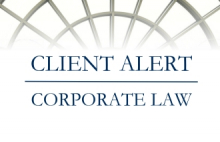Key Guidance on Claiming the Employee Retention Credit under the CARES Act
May 27, 2020See our most recent guidance on the COVID-19 relief bill here.
On April 30, 2020, the IRS answered 94 FAQs on the employee retention credit created by the Coronavirus Aid, Relief, and Economic Security Act (CARES Act), providing much needed clarity to businesses on qualifying for, computing, and claiming the credit. Generally, the employee retention credit is available to employers that continue to pay their employees despite financial hardship stemming from the COVID-19 pandemic. Our prior alert detailing general information about the employee retention credit, along with other tax provisions of the CARES Act, can be found here.
General Assessment of the FAQs
The new guidance provides numerous detailed and valuable clarifications regarding the employee retention credit. Employers and their advisors need to carefully consider this information in making decisions on whether to maintain, furlough, or lay off employees, and in planning to maximize the credit. While the answers to the FAQs are not legally binding on the IRS, they certainly provide guidance for taxpayers to consider when making decisions.
In addition, employers and their advisors need to take the information in the FAQs into account in deciding whether to take advantage of the employee retention credit or apply for a Paycheck Protection Program (PPP) loan. Employers who obtain a PPP loan are generally ineligible for the employee retention credit, unless they repay the loan by May 18, 2020. The benefits of the PPP loan were greatly reduced with the most recent IRS guidance in Notice 2020-32, as the IRS took the position that qualified expenses, including those for rent, utilities, and payroll costs, are not deductible to the extent they are funded by proceeds from a PPP loan that is forgiven (although some members of Congress have suggested that they would like to reverse the IRS position in future legislation). Additional information on Notice 2020-32 and the tax implications of PPP loan forgiveness can be found here.
Both of these considerations need to be taken into account in designing new work arrangements that maximize the credit available.
Highlights of Critical Guidance in the FAQs
Because the 94 FAQs are extensive, this client alert highlights the most critical clarifications employers need to consider.
When are Business Operations Fully or Partially Suspended Pursuant to a Government Order?
An employer qualifies for the credit only if it either (1) fully or partially suspends operations during any calendar quarter in 2020 due to orders from an appropriate governmental authority or (2) experiences a significant decline in gross receipts during the calendar quarter.
The FAQs clarify that an employer has not suspended operations pursuant to a government order if the business is an essential business that is allowed to continue operations, even though closures of other non-essential businesses may affect its operations. A few exceptions are provided, including when suppliers are unable to deliver materials because the supplier has been forced to fully or partially suspend operations due to a government order. Conversely, an employer’s operations will not be considered fully or partially suspended, even if an employer’s workplace is closed due to a governmental order, as long as the employer can maintain operations comparable to levels prior to the closure by requiring its employees to telework.
The FAQs also clarify periods of eligibility once a government order is lifted. A business is only considered to be fully or partially suspended while the governmental order is in effect. Therefore, while the employer is considered an eligible employer for each calendar quarter during which the operations were suspended, the employer can only claim the employee retention credit for wages paid during the period the order is in effect.
An employer who has not fully or partially suspended operations pursuant to a government order may still qualify for the credit if the employer experiences a significant decline in gross receipts.
How Do Health Plan Expenses Factor into Wages for the Employee Retention Credit?
The FAQs illustrate the importance of designing a strategy for paying wages and health care benefits that will qualify for the credit. The FAQs highlight a number of traps for the unwary. The initial IRS guidance provided that employers are only permitted to take health plan expenses into account if the employers also pay employees wages, even if such wages are reduced. On May 7, 2020, the IRS reversed course, and now provides that health plan expenses are considered qualifying wages for purposes of the employee retention credit, even if the employers do not pay employees other wages. Employers who continue to pay health plan expenses on behalf of furloughed employees now appear to be eligible for the employee retention credit, a welcome development for employers who are facing financial issues.
What Amounts Qualify as Wages for the Employee Retention Credit?
Employers need to take into account whether amounts paid to employees are considered wages that qualify for the credit. To complicate matters, different rules apply depending on whether or not an employer averaged more than 100 Full-Time Employees (FTEs) in 2019. The determination of whether an employer averaged more than 100 FTEs requires application of complex aggregation rules that treat businesses that are members of a controlled group or under common control as a single employer. If an employer averaged 100 or fewer FTEs in 2019, the credit is available for all wages paid to all employees after March 12, 2020, and before January 1, 2021, during any period in the calendar quarter in which the employer’s business is fully or partially suspended due to a governmental order or in which the employer has a significant decline in gross receipts. If an employer averaged more than 100 FTEs in 2019, the credit is available only for wages paid to employees after March 12, 2020, and before January 1, 2021, for the time that they are not providing services because the employer’s operations are fully or partially suspended due to a governmental order, or because the employer has experienced a significant decline in gross receipts. Failure to take these complexities into account in making decisions regarding work schedules, wages and benefits may result in the employer receiving a far smaller credit than anticipated.
The IRS also clarified a number of exclusions from qualified wages for purposes of the employee retention credit. Wages paid to employees pursuant to a pre-existing vacation, sick and other personal leave policy are not qualified wages eligible for the credit for eligible employers who averaged more than 100 FTEs in 2019. Payments to former employees, including severance payments, do not qualify for the credit, regardless of whether the eligible employer averaged more than 100 FTEs in 2019. In addition, wages paid by an employer to certain employees who are “related individuals” do not qualify.
How Does the Employee Retention Credit Interact with other Code Sections?
The FAQs clarify a number of issues regarding the interaction of the employee retention credit with other credits and tax benefits that must be taken into account in deciding the amount of the benefit the employer will receive from the employee retention credit. For example, an employer who claims the employment tax credit is precluded from claiming the Section 45S credit for the same wages or the work opportunity credit for the same employee. Further, qualified wages for purposes of the employee retention credit cannot be excluded from an employee’s income as qualified disaster relief payments under Section 139. The loss of these other benefits must be considered in determining whether to claim the employee retention credit.
If you have any questions concerning the employee retention credit, the FAQs, other federal government programs available, or the implications and disruptions of COVID-19 on your business, please contact any of the authors above or another member of the Lewis Rice COVID-19 Task Force.








